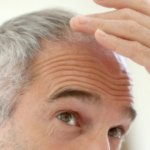Medically reviewed by
Prof Rob McLachlan
What is hair loss?
Male pattern hair loss (also known as androgenetic alopecia) is the most common cause of gradual hair loss, resulting in balding.
Hair loss typically occurs at the front and sides of the head, and in the middle towards the back of the head.
Androgenic alopecia affects about half of all Caucasian men and is a normal part of aging.
It’s more common as you get older (for example, approximately 20% of men aged 20 years and 60% of men aged 60 years have some hair loss). It’s less common in men from non-Caucasian backgrounds.
Causes of hair loss
Hair loss in men, commonly referred to as ‘going bald’, is the result of testosterone affecting the hair follicles of the head.
Hair follicles go through cycles of growth when the hairs get longer, followed by a period of rest and then shedding of the hair.
Cells in the hair follicles convert testosterone to dihydrotestosterone (DHT), which acts on the hair-producing cells to shorten the growth phase.
This results in the follicles shrinking and producing progressively shorter and thinner hairs until they stop producing hair altogether.
Follicles in different parts of the scalp have different sensitivities to testosterone, which accounts for the usual pattern of hair loss.
Male hair loss runs in families. If your father is bald, or if your mother’s father (your maternal grandfather) is bald, you are more likely to go bald than someone whose father and maternal grandfather had full heads of hair.
If your father and maternal grandfather both have hair loss, the likelihood you will go bald is greater than if only one of them had hair loss.
There are many genes that contribute to androgenic alopecia that you may inherit from your mother or father, or both.
Subscribe to our newsletter

Treatment of hair loss
There are a number of ways to treat hair loss in men, including medication.
Minoxidil is a medication that’s applied directly to the scalp and works by increasing blood flow to the hair follicles.
It must be applied twice daily and when you stop using it, hair loss will resume.
Finasteride is a medication taken in tablet form that prevents the conversion of testosterone to DHT.
Lowering DHT levels in the body reduces its effect on hair follicles.
These side effects can continue even after you stop using finasteride, so it’s important to talk to your doctor if you’re considering this treatment.
Like for minoxidil, if you stop using finasteride, hair loss will continue.
A combination of minoxidil and finasteride treatments seems more effective than either treatment alone.
Hair transplantation is a satisfactory treatment for the majority of men who have it that effectively reverses hair loss.
Wearing a toupee or wig to cover hair loss is satisfactory for some men.
Laser therapy, microinjection, prostaglandins, valproic acid, saw palmetto extract, and the use of platelet-rich plasma are emerging treatments for androgenic alopecia, but there’s not a lot of evidence to support their use.
Health effects of hair loss
It’s not possible to predict if you’ll experience hair loss, or what the extent of your hair loss will be if it occurs.
Hair loss can cause a lack of self-confidence and self-esteem, loneliness and depression in some men, particularly those affected at a young age.
For these reasons, treatment can be beneficial for some men, but the number of men who seek treatment is relatively low.
What to do about hair loss
If you’re concerned about hair loss, speak to your doctor to find a way of dealing with it that suits you.












